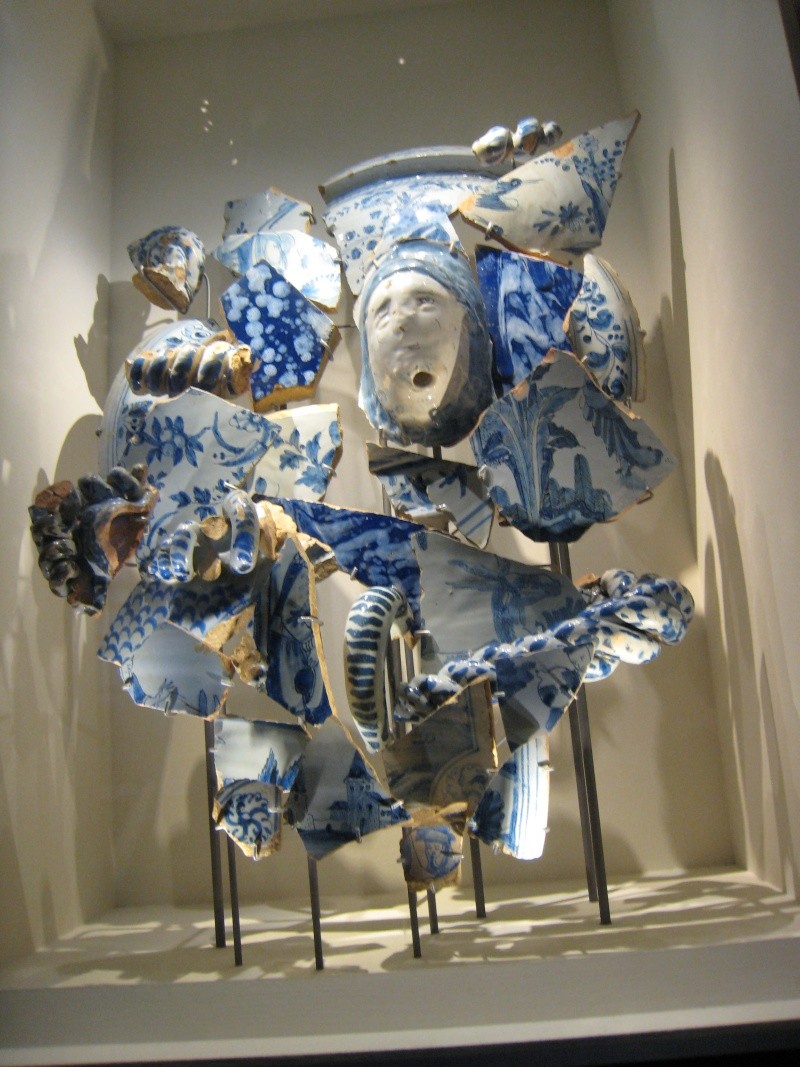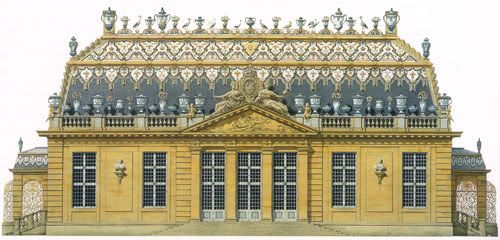Louis le Vau - the King's architect - was entrusted with the task and he designed a cluster of five pavilions which were then built by Francois d'Orbay. The new construction gained its name from the white tiles used to adorn the exterior of the pavilions - this style was inspired by Asian influence, in particular the wonders of Nanking. As such it was the first royal building to be directly inspired by the Oriental fashions. In order to get the required tiles it was necessary to import some from Holland while others were created in Rouen, Nevers, Lisieux and Saint-Clement.
 |
| Plan of the Trianon de Porcelaine |
As can be seen from the plan above the five pavilions were not directly connected. The King's house was the one in the top centre - what cannot be seen clearly is that the area was gated making the pavilions and their wonderful garden more private.
What is known is that the pavilions were very intimate compared to the grandiose atmosphere of the King's usual residences. The King's pavilion was only 6,7 metres x 5,7 metres (19 feet wide by 22 feet long). The ceilings were decorated by Francois and Gilbert Francas while the floors were tiled in the style as the exterior. The main living room dominated the King's house flanked by two bedroom suites: Appartment d'Amour and Appartement de Diane.
The stucco, the wood-work and the furnishing were all painted white and blue to match the Delft tiles. Very little of the original furniture survives to this day but thanks to drawings and sketches we are able to describe somewhat what they looked like. Both of the beds were sumptuously carved in intricate patterns and the on in the Appartement d'Amour was inlaid with mirrors from Venice. The wall panels reflects the idyllic ambience intended for the place; shepherds, birds and lovers were all motifs to be found on the walls. As the name of this apartment hints at this is where the King and his mistress spent their evenings.
The twin-apartment - that of Diane - was hung with Chinese tapestries while the furniture continued the colour theme of blue and white. The Dutchman, Pierre Gole, was in charge of delivering the furniture for the retreat.
The remaining four pavilions had one purpose: to prepare food for the King and Madame de Montespan. Both of them loved fine dining and in the Trianon de Porcelaine they found a place to indulge fully in their shared passion. One pavilion prepared soups, another jams, a third hors d'oeuvres and entrees and the last fruit. The location of the small kitchen meant that the couple could follow the process while preventing having to let in a continuous flow of servants from the palace.
The gardens of the Trianon de Porcelaine is the only bit of the former pleasure retreat that still exists. It followed the baroque ideal of strict lines and was divided into three parts.
The terrace had a fountain providing the water the King loved so much while Michel II de Bouteux came up with a new idea. Rather than planting flowers directly into ground he suggested that flower pots should be interred so that it was easy to swiftly change flowers. Thus, the King and his mistress could enjoy fresh flowers all year around with the hot-houses providing summer flowers in winter. It also spared the royal eyes from seeing dead flowers since they were simply removed.
On the occasions that the King did invite guests to his garden he could impress them by presenting one array of flowers on the first inspection and a completely different one on a second glance. It is no wonder that the place became known as the Palace of Flora; here springtime seemed to always reign.
In fact, the Trianon de Porcelain received the majority of the flowers imported. In 1683 just about 68.000 hyacinths, narcissi, tuberoses and jonquils were imported from southern France. Of these 18.000 were sent immediately to the Trianon de Porcelain while the park of the palace received merely 5.500.
The garden sloped down towards the Grand Canal which provided perfect conditions for the orange trees so beloved by Louis XIV. Incidentally, Madame de Montespan and Louis XIV both enjoyed strongly scented flowers; consequently, the gardens were awash from the scents of orange blossom, tuberoses and the like. Not everyone shared the two's love of heavy scents and on one occasion the King was obliged to lead his courtiers out of the garden because "the scent of tuberoses hung so heavily in the air". The King used the gardens of the Trianon de Porcelaine as a showcase of his influence. Rare and exotic flowers were cultivated here with seemingly ease.
In the lower garden - separated from the terraces by a wall - were two more attractions. One were a couple of removable greenhouses which provided shelter for the orange trees during the cold winters. The other was a testament to the couple's love of scents: a perfumery. Here the essences of the garden's flowers were extracted to create intoxicating perfumes for the lovers. Today, the Garden Salon of the Grand Trianon sits on this spot.
The entire construction of the Trianon de Porcelaine amazed even the French courtiers. André Felibien wrote that the court viewed it as an "enchantment" especially since the construction was done so quickly: "even though it had not been started at the end of winter it was found done at springtime, as if it came out of the earth with the flowers...".
Rumours had it that the houses were constructed with porcelain while in reality they were normal brick houses coated with tiles. In an effort to add to the idea of a world of porcelain the metal flower pots were painted to like as if they, too, were of porcelain. Those courtiers who were lucky enough to be invited there were mesmerised.
Sadly, the romantic retreat was not to last. When Madame de Maintenon had replaced Madame de Montespan she deemed the place "too cold" and advised her lover to have it torn down. This order was carried out in 1687.
 |
| Pieces of porcelain from the Trianon |
The stucco, the wood-work and the furnishing were all painted white and blue to match the Delft tiles. Very little of the original furniture survives to this day but thanks to drawings and sketches we are able to describe somewhat what they looked like. Both of the beds were sumptuously carved in intricate patterns and the on in the Appartement d'Amour was inlaid with mirrors from Venice. The wall panels reflects the idyllic ambience intended for the place; shepherds, birds and lovers were all motifs to be found on the walls. As the name of this apartment hints at this is where the King and his mistress spent their evenings.
The twin-apartment - that of Diane - was hung with Chinese tapestries while the furniture continued the colour theme of blue and white. The Dutchman, Pierre Gole, was in charge of delivering the furniture for the retreat.
 |
| View of the centre |
The remaining four pavilions had one purpose: to prepare food for the King and Madame de Montespan. Both of them loved fine dining and in the Trianon de Porcelaine they found a place to indulge fully in their shared passion. One pavilion prepared soups, another jams, a third hors d'oeuvres and entrees and the last fruit. The location of the small kitchen meant that the couple could follow the process while preventing having to let in a continuous flow of servants from the palace.
The gardens of the Trianon de Porcelaine is the only bit of the former pleasure retreat that still exists. It followed the baroque ideal of strict lines and was divided into three parts.
 |
| Reconstruction of the King's pavilion |
The terrace had a fountain providing the water the King loved so much while Michel II de Bouteux came up with a new idea. Rather than planting flowers directly into ground he suggested that flower pots should be interred so that it was easy to swiftly change flowers. Thus, the King and his mistress could enjoy fresh flowers all year around with the hot-houses providing summer flowers in winter. It also spared the royal eyes from seeing dead flowers since they were simply removed.
On the occasions that the King did invite guests to his garden he could impress them by presenting one array of flowers on the first inspection and a completely different one on a second glance. It is no wonder that the place became known as the Palace of Flora; here springtime seemed to always reign.
In fact, the Trianon de Porcelain received the majority of the flowers imported. In 1683 just about 68.000 hyacinths, narcissi, tuberoses and jonquils were imported from southern France. Of these 18.000 were sent immediately to the Trianon de Porcelain while the park of the palace received merely 5.500.
 |
| Table which is believed to have been a part of the furniture of the Trianon de Porcelain |
The garden sloped down towards the Grand Canal which provided perfect conditions for the orange trees so beloved by Louis XIV. Incidentally, Madame de Montespan and Louis XIV both enjoyed strongly scented flowers; consequently, the gardens were awash from the scents of orange blossom, tuberoses and the like. Not everyone shared the two's love of heavy scents and on one occasion the King was obliged to lead his courtiers out of the garden because "the scent of tuberoses hung so heavily in the air". The King used the gardens of the Trianon de Porcelaine as a showcase of his influence. Rare and exotic flowers were cultivated here with seemingly ease.
 |
| View of the gardens (photo by Gérard Blot) |
In the lower garden - separated from the terraces by a wall - were two more attractions. One were a couple of removable greenhouses which provided shelter for the orange trees during the cold winters. The other was a testament to the couple's love of scents: a perfumery. Here the essences of the garden's flowers were extracted to create intoxicating perfumes for the lovers. Today, the Garden Salon of the Grand Trianon sits on this spot.
The entire construction of the Trianon de Porcelaine amazed even the French courtiers. André Felibien wrote that the court viewed it as an "enchantment" especially since the construction was done so quickly: "even though it had not been started at the end of winter it was found done at springtime, as if it came out of the earth with the flowers...".
Rumours had it that the houses were constructed with porcelain while in reality they were normal brick houses coated with tiles. In an effort to add to the idea of a world of porcelain the metal flower pots were painted to like as if they, too, were of porcelain. Those courtiers who were lucky enough to be invited there were mesmerised.
Sadly, the romantic retreat was not to last. When Madame de Maintenon had replaced Madame de Montespan she deemed the place "too cold" and advised her lover to have it torn down. This order was carried out in 1687.

Wow, this is the first I have heard of the Trianon de Porcelaine. I have been to many sites and yours has the most extensive and accurate information. Thank you for all the information which otherwise I may never have known.
ReplyDeleteyou are very welcome and I am glad that you found what you were looking for
Delete